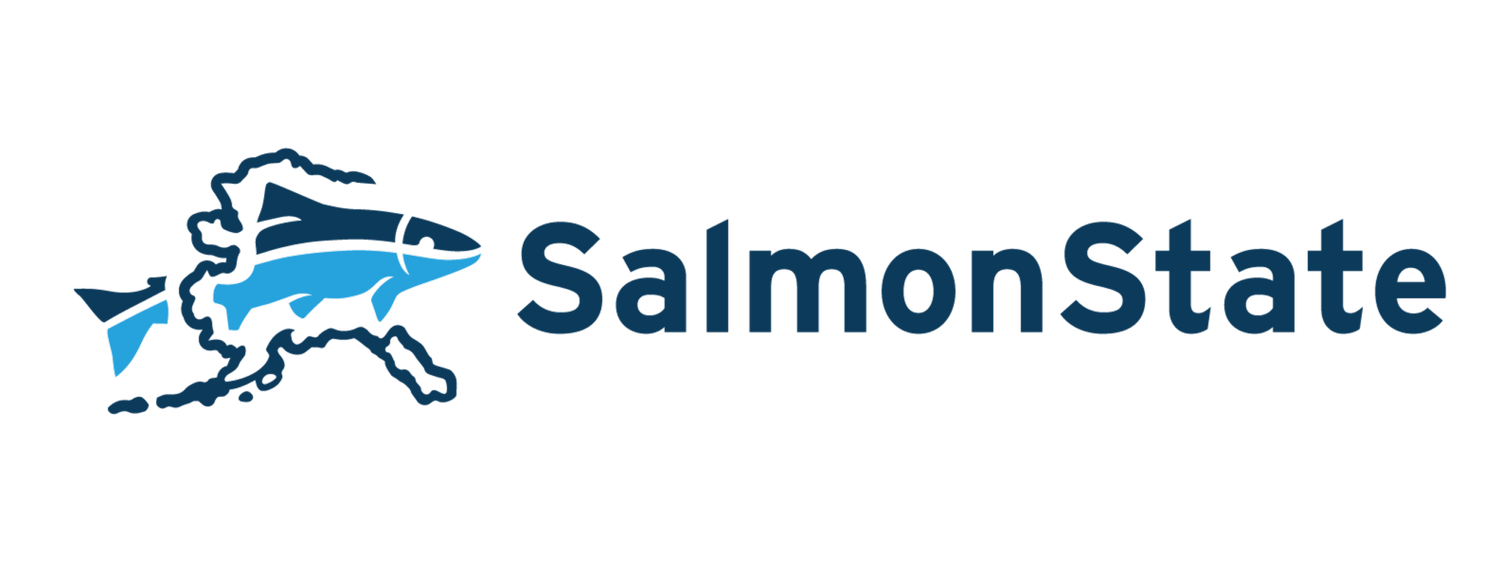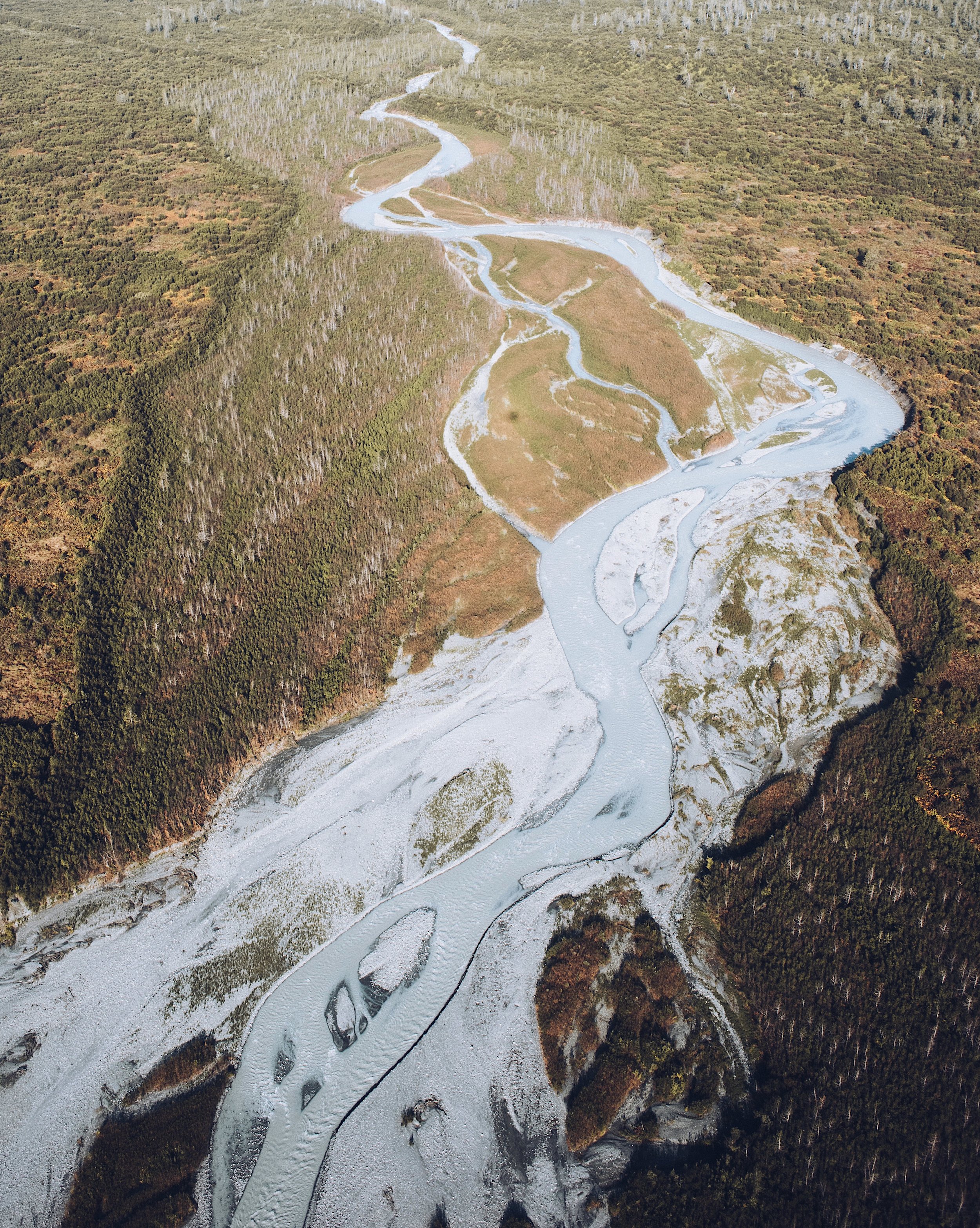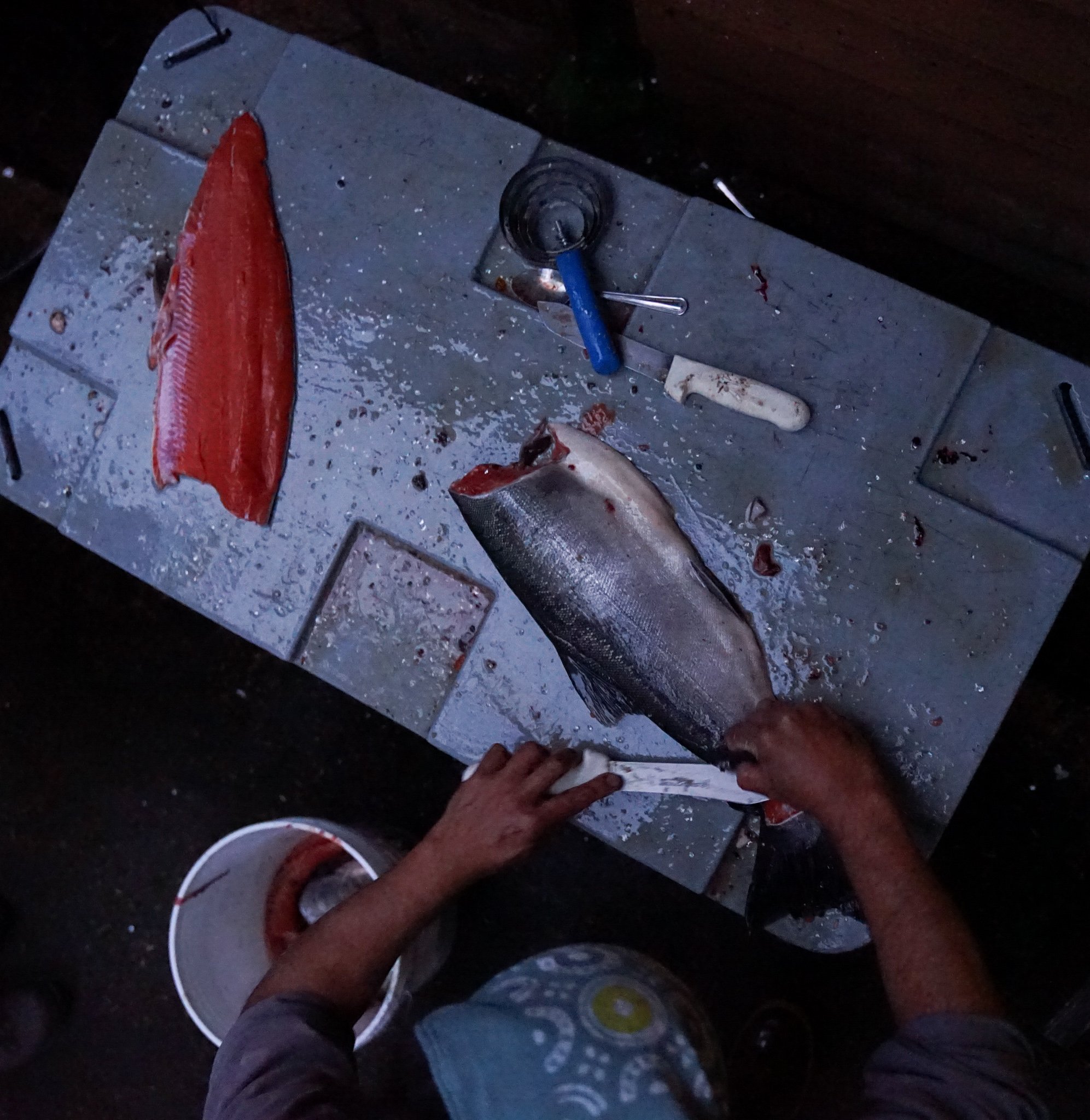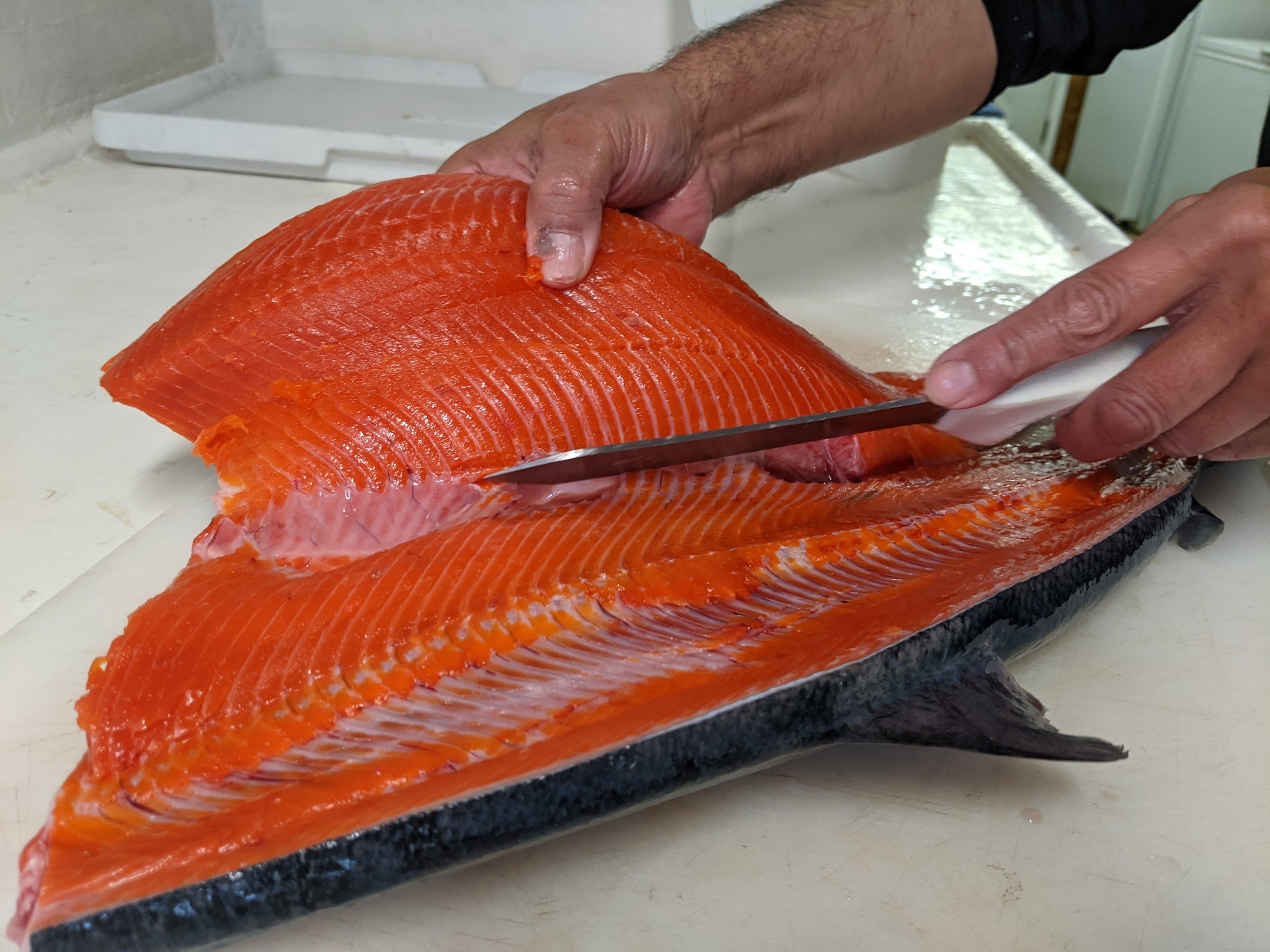Dune Lankard
Photo by Molly Leebove
“My education comes from the Copper River Delta and Prince William Sound. My people, the Eyak, originally migrated out of the interior of Alaska 3500 years ago and ended up east of Yakutat in a place called the Ikaleo river. We migrated 300 miles across icebergs in the Copper River Delta, and as the glaciers were receding, a thin area of habitat was being formed along the coast. It wasn’t enough to support thousands of Eyaks– maybe several hundred. So in the history of time, we’ve never numbered more than 1000 Eyak people along the coast.
The Eyak are salmon people– salmon is who we are. And we are the richest people in the world when those salmon come back. The wonderful thing about my family was we always had more. We were fisher people– all of us grew up as fishermen and made a living from the sea, whether it was longlining, crabbing, gillnetting, seining, tendering– whatever it was– the ocean took care of us in ways that most people would never understand.”
—Dune Lankard, Founder and President, Native Conservancy
Photo by C. Hoover
“Growing up, I started fishing when I was five. We were seven little Indians, and my grandmother and mother would teach us about the seasons of animals, fish and plants, and how they all relate to our fishing way of life. Like a lot of people in our region, we grew up living the wild salmon way of life.
My first season out there, even though I was a young pup, I was learning the ropes– how to stay safe, not fall overboard, and still look for fish. My first job was to look for jumpers and see which way they were going. My father taught me that in order to track the salmon, you have to think like a fish. That sunk into my mind– that for every jumper I saw, I needed to know which way it was going. Back then, we had “walking dogs,” or chums that would jump five, six or sometimes seven times in a row in a circle while running in a school. These “wild dogs” were almost impossible to catch– in order to do so you literally had to think like a fish. Then when I was old enough, I learned to run the power block. I remember I had to be really alert because if somebody got hung up, you could take them out.
Sometimes while seining, we’d get salmon sharks in our net. I remember one day, we had four or five salmon sharks in a single set. Another time, I was walking around, and I remember a shark came up out of the water, headed straight at me. I slipped and fell, and my leg was hanging over the seine. The shark was scared for its life, and for a moment, I was scared for mine. But then I realized it would have to jump onto the boat to get me. I also realized the situation was caused by us because we had it in our net. If we weren’t encroaching on its habitat and its subsistence lifestyle, then it wouldn’t have gotten caught up. A lot was processed in my mind at that moment.”
—Dune Lankard, Founder and President, Native Conservancy
Photo by Ash Adams
“When I think about salmon, I think about a story that happened about fifteen years ago:
I was invited to my first potlatch, and it was in Washington State. There were four or five tribes in attendance, and all of these grandmothers, amazing songs, dances and events. Eventually it came to a moment where everyone was giving gifts to those in attendance– whether it be blankets, trinkets, t-shirts– those sorts of things. Well, I happened to have seven jars of smoked Copper River king salmon that I had made with my sister Pamela. Pamela was my best friend and my spiritual guru, and we’ve smoked thousands of cases of salmon over the years.
So I had seven jars in my backpack, and there were these seven grandmas sitting in a circle. I went over and gave each one of them a jar, and said “This is from the Eyak in the Copper River, and this is our smoked Copper River king for you.”
Some of the women started crying, and I wondered, “Did I do something wrong?” I looked at a friend and asked, “Did I give this salmon to the wrong people?” My friend said, “Dune, they are the Chinook people, and they haven’t had wild king salmon in over 25 years. And so you just shared a gift with them that they can no longer get from the sea.”
My heart, my spirit – I felt like no matter what I was doing, it would never be enough – for them, for me, for us – and I knew from that point on that I had to work harder than ever before. They thanked me profusely and were so appreciative. Later I went home and told Pamela what had happened. I reflected, ‘What we have is so precious, and this is who we are. We are the salmon people here, and we can’t let this happen to us on our watch. We can never lose our wild salmon way of life.”
—Dune Lankard, Founder and President, Native Conservancy
Photo by Molly Leebove
“The thing about the Copper River Delta and Prince William Sound is that they are two sister watersheds that can’t survive without the other. All of the silt that comes out of the Copper River, which is probably in the tens of millions of pounds annually, ends up in Prince William Sound. When you see satellite images, you can see the flow of silt between the watersheds, and that silt helps Prince William Sound in so many ways. The salmon runs share both ecosystems. There are 15 different whale species that come through every year… the beauty and bounty of the region is unparalleled. That is why we fight for what we do.
After the Exxon Valdez oil spill, I was speaking about 250 times a year. After my travels, I would come back to Pamela’s house, and I’d want to tell her what I saw. But every time, she would hand me a salmon and tell me, “Go filet the salmon, and then we’ll talk.” Immediately I was involved in this ritual and ceremony. As soon as I started fileting a salmon, I realized this is why I left– this is why I do what I do.
I would thank her and we would talk about what I saw– how people were fighting for green spaces on the top of buildings in New York, and how people are trying to reverse desertification happening before their eyes. Wild places being clear cut, strip mined, drilled, and paved. I realized we were from a very special place, and how special it is to fight for our home. The wild, Copper River sockeye and king salmon, and our way of life. This is truly comparable to no other way of life out there. It’s something a lot of people don’t understand.”
—Dune Lankard, Founder and President, Native Conservancy
Photo by Nels Evangelista
“I was born in 1959, when we were still a territory. 20 days later, in July of that year, we became a state. In 1964 we had the Good Friday earthquake that rocked our world, rocked our fishery, and turned everything upside down. Then 25 years later to the day, on Good Friday in 1989, we had the Exxon Valdez oil spill in our backyard. And nearly 25 years later now, we’re dealing with climate change. We’ve proven that we are a resilient community and that if left alone, the fisheries are able to restore themselves. But I don't know if that can happen this time around with ocean acidification and ocean warming.
Alaska is colder and has been colder than most regions on the planet, but with the warming and heating of the ocean and air, we are seeing changes. Usually in May when we start fishing on the Copper River Delta, your water temperatures will be around 45-50 degrees, which is perfect. But the last several years it's been around 55 and even as high as 60 degrees. Spawning numbers are down, and it’s terrifying. Four years ago, only 44,000 sockeye salmon came back to the Copper River. The following year, the ocean heated up to 76 degrees for three weeks, 20 feet below the surface. What that meant was that millions of krill, mussels, wild kelp forests, salmon and birch died because there was no oxygen in the water due to the heat. The salmon also didn’t have any fresh water streams to go up into, so a lot of them had to spawn in the intertidal zones. Then, when we had our fall monsoons, a lot of those eggs got washed out. So the mortality rate was higher than normal. The following year only 85,000 sockeyes came home, and last year, 500,000 were harvested, which is still only a ¼ or less than what we would normally have in an annual run of 1-2 million sockeyes.
So changes are happening before our eyes. I think people who grew up in the Copper River Delta and in Prince William Sound have that traditional Indigenous knowledge, and it is critical for people to hear that knowledge in order to understand that there are major changes happening in our region and to our fisheries.”
—Dune Lankard, Founder and President, Native Conservancy
Photo #1 by Molly Leebove
“Not only are the run sizes smaller, but the salmon themselves are smaller in size. Our kings are down to 17.5 pounds on average from 22 pounds, sockeyes from six to four and a half pounds, pinks dropped as low as a couple pounds, and chum are down to 7.5-8 pounds from 10.
Glaciers are melting at unprecedented rates. Two or three years ago, you had Sheridan Glacier that you could walk out onto from the shoreline. Now, it’s Sheridan Lake, and the glacier is a mile from the shoreline. What happens when you have less glacier runoff is the water temperatures heat up, and the salmon end up with more worms and parasites. You have fish with bigger heads and smaller bodies. It’s similar to what’s happening on the Yukon. There are going to be big changes in our environment. We are getting more floods and rain– we’re seeing it. The good old days are over.”
—Dune Lankard, Founder and President, Native Conservancy
“Two and a half years ago I was inspired to focus on food security after hearing two talks: One, by Winona LaDuke on why food systems are important to building your community, and the other by Dr. Elizabeth Hoover, who wrote an article titled, “How can you call yourself sovereign if you can’t feed yourself?” To me, that was the wake up call that we needed to create a food security program, especially during Covid when a lot of the elders and families who would normally be out harvesting berries, salmon, mushrooms and deer were not going out.
The idea started when I met Bren Smith– another Ashoka Fellowship cohort member. I remember we would go to events and no one would talk to us because we looked like a couple of fishermen while everyone else was dressed in suits. So Bren and I would hang out and have a beer. He was from an outfit called GreenWave in Connecticut that focuses on regenerative farming techniques for aquaculture. One day I looked at him and said, “You know man, you’re the future, and I’m the present. I’m still out there making a living on the ocean. When our fisheries crash, I’ll give you a call.”
Shortly after the conference, a friend of mine called and said there was an interesting show on 60 Minutes. He told me to watch it. Turns out, it was a story about Bren and his kelp farm in New Haven. So I gave Bren a shout, and I learned that beyond acting as a food source, kelp can actually be used to address ocean acidification and warming waters. So I started doing my research, and handed out copies of his book to friends. I wanted to figure out how we could bring kelp to our region.”
—Dune Lankard, Founder and President, Native Conservancy
Photo by Ash Adams
“There is a Native saying that, “when the tide is out, your table is set.” I remember as a kid, we’d go out and scour the shorelines at minus tide to gather kelp, and we’d dry it and eat it all summer. All of the Indigenous people along the coastline have been harvesting kelp for thousands of years.
My sister Pamela found an article in the Cordova Times from around 1907. There was a reporter who saw two Native women who had just arrived off a boat on the Bering River 100 miles east of Cordova. In one of the woman’s hands, he saw what looked like a brick of coal from the Covenant Bering River coal field, so the reporter thought he had a story. But when he pulled what was under her arm out and under the eye, the reporter discovered that it was a kelp cake. He asked what it was, and they explained it was a brick of kelp– they cold pressed it, taking layers of kelp, berries, and hooligan and pressing it together. It was like America's first energy bar. You always want a kelp cake on your boat or on a long hunt or travel because if anything happens and you can’t catch something, at least you have a high energy kelp cake that you can chew on to keep you strong and healthy.
In many stories about pioneers and folks “discovering” Alaska, they didn’t know how to hunt or fish and ended up getting themselves in trouble. They would come to shore, and the only thing they could find was the kelp. They would eat it, and it gave them nutrients to stay alive. This happened on many occasions.”
—Dune Lankard, Founder and President, Native Conservancy
Photo by Ayşe Gürsöz
“Our fishing industry starts in May and ends in October. In kelping, we start in October and end in May. So kelp is an important complement to the salmon culture here in Cordova. The idea for kelp farming and mariculture farming is that we’re building a regenerative economy that’s actually based on restoration, conservation and mitigation.
Kelp is the hemp of the sea. It’s this miracle microorganism that can grow 18-24 inches a day, making it the fastest growing organism on the planet. Kelp has 14 or more vitamins that they know of. It has 10 times more calcium than milk, it has iodine that can help a lot of people with throat issues, omegas, and nutrients that provide energy. Once it’s processed, you can turn it into 150-200 different types of food products. If you put 2% kelp into animal feed and feed it to cows and pigs you can reduce their emissions by 50-60%. You can create pharmaceuticals, nutriceuticals, biofuels, bioplastics, fertilizers, compost– the list goes on.
We’re building a community kitchen right now so we can experiment and test these products ourselves, and bring back to life several thousands of years of history in relationship with this kelp. We’re reviving the spirit of the Indigenous peoples and the relationship with the ocean that we’ve lost over the last 150 years. We’re creating an opportunity to get out on the ocean on our own terms and grow our own food and take care of our people.
On the environmental side, kelp creates habitat which allows 300 other species to exist. It can also sequester carbon at a 5-20 times greater rate than living terrestrial forests. This is one of those opportunities where it's one solution out of 1000 that really needs to be funded and implemented if we are serious about changing the course of history on the planet.”
—Dune Lankard, Founder and President, Native Conservancy
Photo by C. Hoover
“My first income from the sea was herring roe on kelp at the age of twelve. Now, here I am 50 years later at sixty two, and one of my last incomes from the ocean will be from growing kelp farms to help the critters in the sea. It feels ironic and only right that I am doing what I have always done.
The ocean has always provided a way of life for me and my family, and I want the ocean to provide for my daughter Ananda. Because the ocean gave to me, it’s my turn to give back to the ocean and do everything in my power to help the ocean take care of itself. The environment is a special place. It can recover– take back, rebuild and survive. But healing takes time, and we’ve got to do things differently. The ocean is one of our best hopes to get something right. I feel like as long as the right minds and right people with the right spirit come together, they can address these changes. But as long as the same dumb leaders keep leading us, we’re going to go down a path we don’t want to go on. I don't want to read that case study. I want to read and hear about what good is happening on the planet. What we’re doing to make a difference. I want to change the narrative and figure out how to work on solutions everyday that make a positive difference, not only for the environment, but also the human race.
We’re brighter than this, smarter than this. But it takes conviction, and a plan. I don’t see that yet. What we need are leaders who understand the flow and can realistically acknowledge what is happening to the planet and what our role is within it. We need leaders who can come up with a plan that works with the human race. Then we’ll have a chance.”
—Dune Lankard, Founder and President, Native Conservancy
Photo by Will Saunders
“My daughter Ananda, what is she going to inherit besides our bad decisions? Besides the pollution we leave her with? What choices will she have? Well I’ll tell you this: As long as she hangs with me, she’ll have opportunities, and she’ll have choices. And she'll be in a position to actually do something that’s part of the solution and healing of our planet.
My biggest hope for the future is the youth. I tell them my exit strategy is you rising. If I'm able to put them in a position to rise with all of my energy, I will. We need to groom new leaders that are youthful and can understand that we have a long way to go, and it's not just about money or taking the last of the fossil fuels out of the ground to figure out how to keep pumping oil into our veins.
We have a lot of education, but people need to rise up around the world and say this kind of leadership is over. We’re not going to tolerate it anymore. We as a human race are going to be eradicated if we don’t wise up and smarten up. We need to demand accountability and responsibility, and finance solutions that will change our life for the better. The future holds many blue-green jobs centered around restoring our planet. And I really think that is where we need to go.”
—Dune Lankard, Founder and President, Native Conservancy












